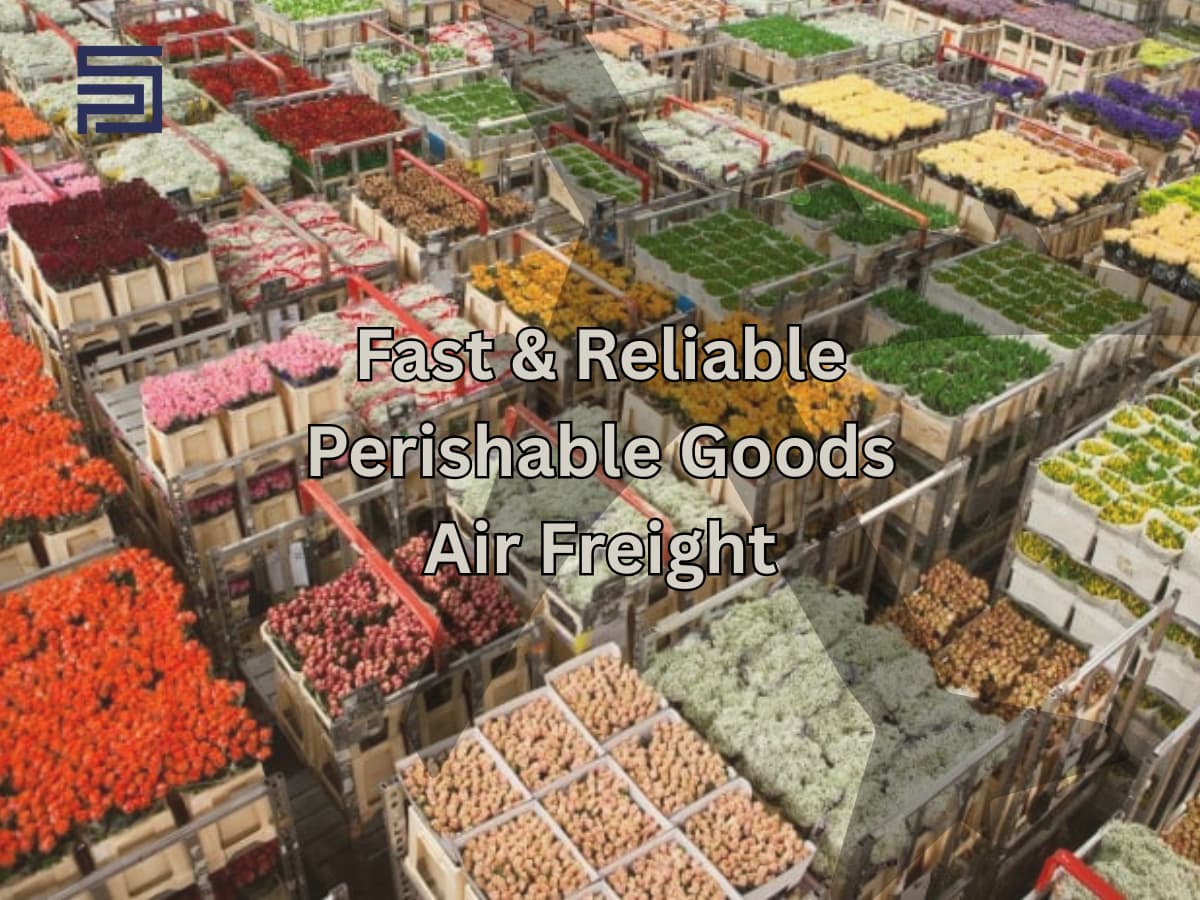What is Perishable Freight?
Perishable freight refers to goods that can spoil, decay, or lose their quality over time if they are not stored and transported under specific temperature or environmental conditions.
These goods have a limited shelf life and require quick, controlled, and careful handling to maintain their freshness, safety, and value during transit.
These include temperature-sensitive items such as fresh fruits and vegetables, dairy products, meat and seafood, flowers, and pharmaceuticals.
Why Air Freight is Ideal for Perishable Goods?
1. Speed and Reduced Transit Time:
Perishable goods such as fresh produce, seafood, flowers, and pharmaceuticals have short shelf lives. Air transport dramatically reduces delivery time, preventing spoilage and ensuring that your products remain in top condition when they arrive.
For exporters dealing with high-value or time-critical items, this speed is crucial for meeting your consumer and market demands.
2. Temperature-Controlled Handling:
Modern air freight systems are equipped with cold chain logistics, temperature-controlled storage, and transport processes that maintain optimal conditions from the warehouse to the aircraft and final delivery.
This minimises exposure to heat or humidity, which could compromise the quality of perishable cargo.
3. Global Connectivity and Accessibility:
Air freight connects almost every part of the world through established flight networks. This means that you can move your perishable goods quickly from the producing countries to consumer markets.
For example, it’s entirely possible to transport fresh flowers from China to Europe or seafood from Nigeria to the United States within a short period while ensuring the products maintain their optimal condition and freshness throughout the journey.
4. Enhanced Security and Monitoring:
Air freight shipments are closely monitored using advanced tracking systems. This allows you to trace your cargo in real-time and receive alerts in case of temperature fluctuations or delays, ensuring accountability and reducing the risk of damage.
5. Compliance with International Standards:
Airlines and freight forwarders handling perishable goods adhere to strict international regulations, such as IATA’s Perishable Cargo Regulations (PCR), which provide detailed guidelines for packaging, labelling, and handling perishable items safely and efficiently.
Perishable Goods Air Freight Rates: What to Expect
Shipping perishable goods by air is often more expensive than other modes of transport, but the higher cost is justified by the speed, safety, and temperature control it provides.
Air freight rates for perishable goods vary depending on several key factors, each influencing the total cost of transportation and logistics.
1. Type and Nature of the Perishable Goods:
Different perishable products require different levels of care. For instance, pharmaceuticals or frozen seafood often demand strict temperature control and insulated packaging, which can increase costs compared to products like fruits or flowers that only require basic cooling.
2. Weight and Volume of the Cargo:
Air freight rates are calculated using chargeable weight, which considers both the actual weight and the dimensional weight (size) of the shipment. Check out our guide on how to calculate your goods' chargeable weight.
Since aircraft have limited space, larger or heavier cargo typically attracts higher rates.
3. Distance and Destination:
The longer the route or the more remote the destination, the higher the freight cost. International routes involving multiple transit points or customs checks can also add to the total shipping price.
4. Temperature Control Requirements:
Maintaining specific temperature ranges, such as frozen (-20°C) or chilled (2°C–8°C), requires specialised containers or refrigerated units (known as ULDs: Unit Load Devices).
The more precise the temperature control your goods require, the higher the cost of shipping it.
5. Packaging and Handling Services:
Airlines and logistics providers, like SARA, handling perishable cargo often charge for specialised packaging, labelling, and handling to ensure compliance with safety standards like IATA’s Perishable Cargo Regulations (PCR).
These services may include pre-cooling, insulated boxes, gel packs, or dry ice.
6. Seasonal Demand and Market Conditions
Air freight rates can fluctuate during high-demand seasons, such as festive periods, harvest times, or major export windows, when more businesses ship fresh products globally. Limited aircraft space during these periods can drive prices up.
7. Additional Fees and Insurance
Aside from basic freight costs, you may also incur fuel surcharges, customs fees, and insurance charges.
Insurance is particularly important for perishable cargo, as it protects against loss or spoilage caused by delays or temperature fluctuations.
Want to know exactly what your shipping costs should be? Check out our complete guide on shipping costs for all the details.
Average Rate Expectations
While prices vary by route and cargo type, air freight for perishable goods typically ranges from $8 to $18 per kilogram, depending on the factors mentioned above.
Recently, we assisted a client in shipping perishable goods from Lagos to the US, with air freight costs totalling $18 per kilogram; a fair rate considering the distance and temperature-control requirements.
But it is important to note that businesses shipping high-value perishables, like pharmaceuticals or seafood, may pay more due to the stringent handling and temperature requirements.
You can reach out to our expert team to request the shipping rate for your perishable goods.
Best Practices for Shipping Perishable Goods by Air
1. Partner with Experienced Air Freight Forwarders:
Not all logistics providers are equipped to handle perishable cargo. Work with freight forwarders that specialise in perishable goods and are familiar with IATA’s Perishable Cargo Regulations (PCR).
Our experienced partners understand the importance of timing, temperature, and compliance, ensuring smooth operations.
Partner with our certified experts at SARA for safe, reliable, and timely shipping of your perishable goods. Contact us now.
2. Label and Document Clearly:
Proper labelling is essential for both compliance and safety. Clearly mark packages as “Perishable” or “Keep Refrigerated” and include handling instructions.
Also, ensure all required documentation, like the Air Waybill (AWB), health certificates, and export permits, is accurate and complete to avoid customs delays.
You can rely on our expert team at SARA to handle this for you.
3. Schedule Shipments Strategically:
Plan shipments to align with flight schedules and avoid long layovers or weekend arrivals, which can increase storage time at airports.
Always stay in touch with our team at SARA to schedule the best shipping time and minimise handling or transit delays.
4. Monitor Temperature and Humidity:
Utilise real-time tracking and data monitoring systems that alert you to any changes in temperature or humidity during transit. These tools help prevent product spoilage and give you visibility throughout the shipping process.
You can check out our tracking tool at SARA and rely on it to keep you updated.
5. Insure Your Perishable Cargo
Because perishable goods are high-risk, cargo insurance is essential. It protects your shipment against potential losses from delays, temperature deviations, or unforeseen circumstances such as flight cancellations.
Challenges and Solutions in Air Freight for Perishable Goods.
While air freight remains the most reliable mode for transporting perishable goods, it also comes with its own set of challenges.
These challenges, if not managed properly, can lead to product spoilage, financial losses, and delays. However, with the right strategies, our team at SARA is able to effectively minimise these issues.
Below are the major challenges in air freight for perishable goods and the practical tips we recommend you use to overcome them:
1. Temperature Fluctuations:
Perishable goods such as fruits, seafood, dairy, and pharmaceuticals are highly sensitive to temperature changes. A brief exposure to heat or cold during loading, offloading, or storage can cause spoilage or quality degradation.
Solution:
Use temperature-controlled packaging like insulated boxes, refrigerated containers, or thermal blankets. Implement cold chain monitoring systems that track temperature and humidity in real time.
2. Delays in Transit or Customs Clearance:
Customs delays, missed flight connections, or long layovers can increase transit time and expose goods to unsuitable conditions.
Solution:
Work with experienced freight forwarders who specialise in perishable cargo. Ensure complete and accurate documentation (including health certificates and permits) to prevent clearance delays. Contact us today and get access to the best shipping partners for your perishable goods.
3. Inadequate Packaging:
Poor or inappropriate packaging materials can lead to leaks, contamination, or loss of temperature control during transit.
Solution:
Follow the IATA Perishable Cargo Regulations (PCR) when selecting packaging materials. Use leak-proof, insulated, and ventilated containers based on product type.
Always label shipments clearly with “PERISHABLE” and handling instructions. You can also rely on our experts at SARA to help you with this.
4. Limited Cold Storage Facilities at Airports:
Not all airports have sufficient cold storage or temperature-controlled holding areas, especially in developing regions. This increases the risk of exposure to unsuitable conditions before or after flights.
Solution:
At SARA, we choose airports and airlines with dedicated perishable handling facilities. We also handle the logistics to ensure quick transfer from aircraft to refrigerated vehicles or cold storage upon arrival.
5. High Shipping Costs:
Air freight for perishable goods can be costly due to specialised equipment, packaging, and temperature control needs.
Solution:
Plan shipments efficiently to maximise cargo space and reduce per-unit cost. Work with our freight forwarding service, and we will provide consolidated shipping options and optimise routes.
Though costs are higher, faster delivery minimises spoilage and often saves money overall.
6. Regulatory and Compliance Issues:
Different countries have varying import/export regulations for perishable goods, leading to possible compliance errors or detentions at customs.
Solution:
Stay updated with destination-specific regulations and partner with our freight forwarders at SARA, as they are familiar with the international standards. They ensure all permits, licenses, and health certificates are properly obtained before shipping.
Ship Your Perishable Goods With SARA
Shipping perishable goods does not have to be so risky and costly; with the right partner, you can do it with ease.
Choose SARA as your perishable goods partner and get peace of mind at every step of the cold chain. We pair industry-leading cold-chain practices and IATA-aligned SOPs with experienced freight partners to reduce transit time, minimise risk, and protect product value.
Whether you’re exporting fresh produce, seafood, pharmaceuticals, or flowers, our team will design the right packaging, routing, and monitoring solution for your needs.
Ready to ship? Contact SARA for a free consultation and a customised quote. Let’s keep your perishables fresh and profitable.
Frequently Asked Questions (FAQs)
Which type of transport is suitable for perishable goods?
Air transport is often the most suitable for perishable goods due to its speed and ability to maintain strict temperature controls.
What are perishable cargo examples?
Examples include fresh fruits, vegetables, dairy products, seafood, and pharmaceuticals.






Comments
Please log in to leave a comment.